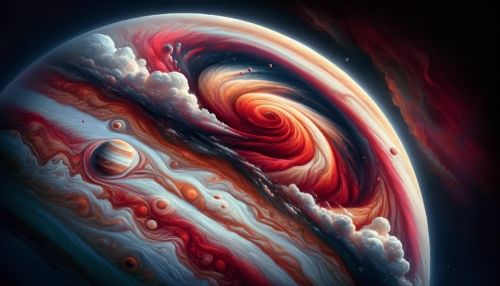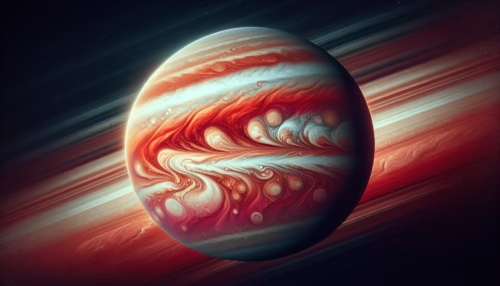Have you ever wondered about the mysteries that lie in the swirling clouds of our solar system’s largest planet? Jupiter, with its distinctive bands and spots, has captured human imagination for centuries. Among all its features, the most famous is undoubtedly the Great Red Spot—a vast, persistent storm larger than Earth itself. Today, we will unravel the enigmas surrounding this colossal atmospheric phenomenon, examining its origins, nature, and the insights it offers into planetary science.

Table of Contents
The Enigmatic Great Red Spot: A Historical Perspective
The Great Red Spot (GRS) is not merely a contemporary fascination; it has been a subject of astronomical study since the 17th century. First documented with telescopic observations, this persistent storm provides a historical lens into the evolution of planetary study.
Early Observations and Discoveries
The first recorded observation of the Great Red Spot dates back to 1665 when astronomer Giovanni Cassini used a telescope to study Jupiter. However, it wasn’t consistently observed until the early 19th century. Its reddish hue and substantial size quickly made it a focal point for astronomers, prompting a variety of hypotheses ranging from its composition to its permanence.
Evolution in Understanding
As telescopic technology advanced, so did our understanding of the Great Red Spot. What was once thought to be a solid landform on Jupiter’s gaseous surface became recognized as a massive storm. Observations over time revealed that its size and color changed, hinting at complex atmospheric processes beneath the clouds.
Nature and Structure of the Great Red Spot
To understand this Jovian tempest, it is essential to delve into its physical and chemical makeup. The Great Red Spot isn’t a storm like those on Earth; it is a substantially more complex system.
A Gigantic Anticyclone
At its core, the Great Red Spot is an anticyclonic storm, meaning it rotates in a direction opposite to that of low-pressure systems found on Earth. Its dimensions are staggering, with the storm’s widest span measuring about 16,350 kilometers (10,159 miles) across, roughly 1.3 times the diameter of the Earth.
Composition and Color
The distinct reddish color has mystified scientists for decades. While its exact cause remains unclear, theories suggest it could be due to chemical compounds like complex organic molecules, red phosphorus, or sulfur compounds reacting with ultraviolet light from the Sun. Understanding these chemicals offers insight into the atmospheric conditions on Jupiter.
Dynamics and Stability
Intriguingly, the Great Red Spot maintains its shape and rotation speed, despite ongoing turbulence and energy dissipation. Its stability might be fueled by Jupiter’s massive heat source and the storm’s own internal dynamics, such as potential vorticity, which helps conserve energy even amidst turmoil.

The Atmospheric Phenomena Behind the Storm
To fully grasp why the Great Red Spot exists, one must examine the atmospheric conditions on Jupiter, a gas giant with an extraordinarily dynamic climate system.
Jet Streams and Vorticity
Jupiter’s atmosphere is characterized by fast-moving jet streams flowing in opposing directions. The Great Red Spot lies between two such jet streams, where the interaction produces vorticity—a rotational effect that helps maintain the storm’s longevity. Unlike storms on Earth that dissipate in a matter of days or weeks, this vorticity allows the Great Red Spot to persist for centuries.
Energy Sources and Heat Flux
Unlike Earth, where solar heating is the primary driver of atmospheric activity, Jupiter’s storms are powered mainly by internal heat. This massive heat flux from below fuels ongoing atmospheric disturbance, allowing giant storms like the Great Red Spot to thrive.
Key Theories and Models
Various scientific models have arisen to explain the persistence and dynamics of the Great Red Spot. Let’s consider some of the prevailing theories.
The Shallow-Water Model
The shallow-water model posits the Great Red Spot as a shallow phenomenon, largely confined to the upper layers of Jupiter’s atmosphere. This model leverages the planet’s vertical structure, suggesting that differences in temperature and wind speed create conditions conducive to the storm’s longevity.
The Deep Atmosphere Model
Alternatively, the deep atmosphere model suggests that the Great Red Spot’s influences extend far below the visible cloud tops. This would mean the storm has deep roots within Jupiter’s gaseous layers, sustained by differences in temperature and pressure throughout the atmospheric depths.
Computational Simulations
Advanced computer simulations have been crucial in testing these models. They help validate theories about atmospheric dynamics, revealing how vortices interact and evolve over time. These simulations provide invaluable insights, bridging the gap between observational data and theoretical predictions.

Modern Observations and Technological Advances
In recent decades, technological advancements have greatly enhanced our ability to study the Great Red Spot, offering unprecedented detail and accuracy.
The Role of Space Missions
Space missions like Voyager, Galileo, and Juno have revolutionized our understanding of Jupiter and its Great Red Spot. Juno, in particular, equipped with state-of-the-art instruments, provides high-resolution images and data, allowing scientists to observe the storm’s dynamics in new ways.
Ground-Based Telescopes and Their Contributions
Ground-based telescopes, augmented with adaptive optics, continue to play a critical role in observing Jupiter from Earth. They provide long-term datasets that track the storm’s changes, complementing the data from space missions.
Spectroscopy and Imaging Techniques
Spectroscopic techniques have been vital in examining the atmospheric composition of the Great Red Spot, while imaging technologies have helped chart its movements and structural changes over the years. These tools enable scientists to delve deeper into the atmospheric processes at play.
Implications for Understanding Jupiter’s Atmosphere
Deciphering the Great Red Spot goes beyond curiosity; it has profound implications for understanding Jupiter’s atmosphere and, by extension, those of other gas giants.
Insights into Atmospheric Dynamics
Studying the Great Red Spot provides a window into the broader dynamics at play in Jupiter’s atmosphere. The insights gained help refine models of atmospheric circulation and storm formation, applicable to both Jupiter and potentially the atmospheres of other planets.
Broader Planetary Science Impact
The lessons learned extend to exoplanetary studies. Gas giants like Jupiter are common in other solar systems, and understanding their atmospheric behaviors could inform our understanding of these distant worlds.
Contributions to Climate Models
The mathematical and physical principles derived from studying the Great Red Spot contribute to more accurate climate models, shedding light on phenomena that may not yet be fully understood in Earth’s atmosphere.

Future Prospects and Research Directions
The quest to understand Jupiter’s Great Red Spot is ongoing. Advancements in technology and continued exploration promise to shed more light on this captivating storm.
Next-Generation Space Missions
Proposed missions, like the European Space Agency’s JUICE (Jupiter Icy Moons Explorer), aim to study Jupiter’s environments further. These missions will likely provide deeper insights into its atmospheric phenomena, offering more clues about the Great Red Spot.
Technological Innovations
Future innovations in telescopic and imaging technologies will enhance our capability to observe and interpret the dynamics of the Great Red Spot, facilitating new discoveries and revising existing theories.
Collaboration and Data Sharing
As technology advances, so does the importance of collaborative efforts and data-sharing among international scientific communities. Such collaboration will accelerate the pace of discoveries and broaden our understanding of planetary meteorology.
Conclusion: The Eternal Mystery of the Great Red Spot
The Great Red Spot remains one of Jupiter’s most intriguing features. Its size, persistence, and enigmatic nature continue to captivate scientists and astronomy enthusiasts alike. By studying this celestial phenomenon, we gain valuable insights into not only Jupiter’s atmosphere but also the principles that govern atmospheric dynamics on a planetary scale. As research progresses and new technology emerges, the mysteries of the Great Red Spot will gradually unravel, redefining our understanding of the gas giants and expanding the horizons of planetary science.
Finally, I invite you to consider the broader implications of these discoveries in our search for understanding the universe. What questions do you have about the Great Red Spot, and how do you think continued study of Jupiter could impact our knowledge of Earth’s atmospheric processes? Feel free to share your thoughts and delve into related articles for more advanced insights into planetary weather systems and their complexities.


